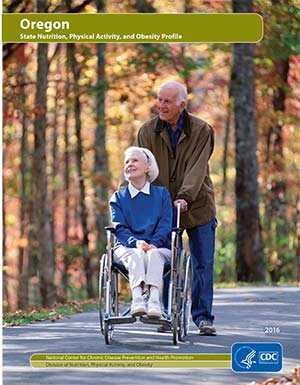Oregon State Nutrition, Physical Activity, and Obesity Profile
Many American communities lack environments that could support healthy diets and regular physical activity. Healthy dietary and physical activity practices can lower the risk for heart disease, type 2 diabetes, and some cancers.1,2
In addition, excess calorie intake and physical inactivity contribute to obesity, which is associated with some of the leading preventable chronic diseases, including heart disease, stroke, type 2 diabetes, and some cancers. Among adults, the medical costs associated with obesity are an estimated $147 billion.1,2,3
Public health approaches can help make healthy options available, accessible, and affordable. The Centers for Disease Control and Prevention’s Division of Nutrition, Physical Activity, and Obesity (DNPAO) supports the nation to establish sustainable programs to improve dietary quality, increase physical activity, and reduce obesity and overweight. DNPAO funds and works with state health departments through a cooperative agreement (State Public Health Actions to Prevent and Control Diabetes, Heart Disease, Obesity and Associated Risk Factors and Promote School Health program).
This profile highlights data on dietary quality, physical activity, and obesity in Oregon and select activities funded with this cooperative agreement. For more information about CDC’s work to support healthy eating and physical activity, please see the DNPAO website.
Population Statistics
Estimated Population of Oregon: 4,028,9774
Adult Statistics
Dietary Behaviors5
- 33.4% of adults reported consuming fruit less than one time daily.
- 16.3% of adults reported consuming vegetables less than one time daily.
Physical Activity5
- 64.1% of adults achieved the equivalent of at least 150 minutes of moderate intensity physical activity per week.
Overweight and Obesity5
- 33.8% of adults were overweight.
- 27.9% of adults had obesity.
Child Statistics
Breastfeeding5
- 93.5% of infants were ever breastfed.
- 64.0% of infants were breastfed for at least 6 months.
Overweight and Obesity5
- 18.3% of children aged 2 to 4 years in the Special Supplemental Nutrition Program for Women, Infants, and Children (WIC) program were overweight.
- 15.9% of children aged 2 to 4 years in WIC had obesity.
State Activities
Oregon worked on the following select activities during the first 2 years of the State Public Health Actions program.
- Launched Promoting Healthy Weight and Development in Early Childhood, a framework with action strategies to help stakeholders address childhood obesity. To promote the framework, Oregon developed communication resources which include presentations, a website, and a brochure that has been shared with over 700 partners.
- Partnered with the Cross- Agency Health Improvement Project (CAHIP) to promote healthier worksites for the Oregon Health Authority and Department of Human Services’ (OHA-DHS) 11,000 employees and 1.4 million annual clients and consumers. CAHIP helped OHA-DHS leadership adopt a wellness policy, which enables and guides employees to work on agency worksite wellness activities. CAHIP also advanced breastfeeding accommodation by including information about state and federal requirements into healthy meetings and events guidelines.
- Awarded Healthy Communities grants for local obesity prevention efforts to nine county health departments and one tribal health department. Grantees were provided guidance and training to promote local policies, systems, and environments that help prevent obesity and chronic disease. Focus areas included worksite wellness, hospital nutrition standards, and active transportation. Some program outputs include healthy vending guidelines, active commute incentive program, a standard that limits sugar-sweetened beverages in a hospital, and a breastfeeding awareness toolkit.
References
- US Department of Health and Human Services. National Institutes of Health. Managing Overweight and Obesity in Adults: Systematic Evidence Review from the Obesity Expert Panel, 2013.
- World Cancer Research Fund / American Institute for Cancer Research. Food, Nutrition, Physical Activity, and the Prevention of Cancer: a Global Perspective. Washington DC: AICR, 2007
- Finkelstein, EA, Trogdon, JG, Cohen, JW, Dietz, W. Annual medical spending attributable to obesity: Payer- and service-specific estimates. Health Affairs. 2009;28(5):w822-w831.
- US Census Bureau. State and County QuickFacts 2015 website. Accessed February 22, 2016.
- Centers for Disease Control and Prevention. Nutrition, Physical Activity and Obesity Data, Trends and Maps website. Accessed February 22, 2016.
- Page last reviewed: September 7, 2016
- Page last updated: September 7, 2016
- Content source:


 ShareCompartir
ShareCompartir
